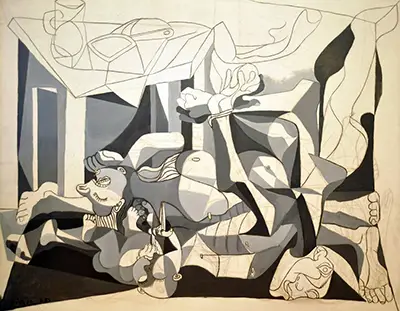Originally born and educated in Spain, Picasso spent most of his adult, professional life in France. He pursued a prolific and wide-ranging career as an artist embracing many styles and artistic disciplines. He is most widely known as a painter and sculptor but also produced works in ceramic, undertook projects as a stage designer and wrote both poetry and plays. He is considered by many to be one of the most influential artists of the twentieth century. Widely respected as one of the founders of the Cubist movement, as one of the pioneers of collage and for the wide variety of styles he developed to express himself in painting.
The Charnel House was painted by Picasso in Paris around the time of, or a little after, the city's liberation from German occupation in 1944 and was mostly completed by about May 1945. Picasso had lived in Paris throughout the German WWII occupation and while he had been subject to the attentions of the Gestapo during these years it would appear that his international reputation had allowed him to continue to work with little interference from the authorities. Though smaller in scale, The Charnel House is reminiscent of an earlier work of Picasso's, Guernica, which he had completed in 1937. Guernica is a large-scale painting on canvas (nearly twelve feet tall and more than twenty-five feet wide) depicting the sufferings of ordinary civilians caught up in the chaos and violence of war. It is seen by many as a powerful indictment of the senseless cruelty of war.
Picasso began work on Guernica shortly after reading accounts of the bombing of Guernica, a village in the Basque Region of northern Spain, by German and Italian warplanes. The painting has a starkly limited palette of black, white and grey and so is reminiscent of the images seen in newsreels and newspapers of the day. A gored horse and a bull feature in the composition and are said to represent the sufferings of the people of Guernica and the brutality of fascism respectively. The Charnel House is an almost domestic scene and on a much smaller scale than “Guernica” yet it has a similar power to shock and appal. It portrays a family; mother, father and children, reduced to a disorderly jumble of corpses strewn on what we take to be their kitchen floor. Above them stands a table, covered by a tablecloth, which has laid out upon it a domestic still life of pots, drinking mugs and food.
The inspiration for this painting may well have been a documentary film that examined the killing of a Spanish Republican family in their kitchen at the time of the Civil War in Spain. It is also the case that at the time this painting was being produced details of the horrors of the WWII holocaust were being reported across Europe. There can also be little doubt that Picasso would have been keenly aware of the parallels to be found in the works of Francisco Goya (1746 – 1828) and his Disasters of War. The painting has the same limited palette, black, white and grey, of Guernica once more reminding us of the newsreels and newspaper reports.
The contorted corpses arranged as a grotesque still life, with the wrists of the father bound together and thrust upwards, emblematic of their helplessness and the impotence of the father to protect his family in the face of such horror. For some The Charnel House appears incomplete as Picasso never painted in the still life laid out on the table above the still life of corpses below it. It could well be, however, that Picasso is admitting that he cannot fully delineate these horrific scenes; he cannot place them in their neat domestic settings and make them understandable. Perhaps he is telling us that in the face of such events, whether they are the holocaust or the horrors of modern warfare, the artist’s hands are also tied.

